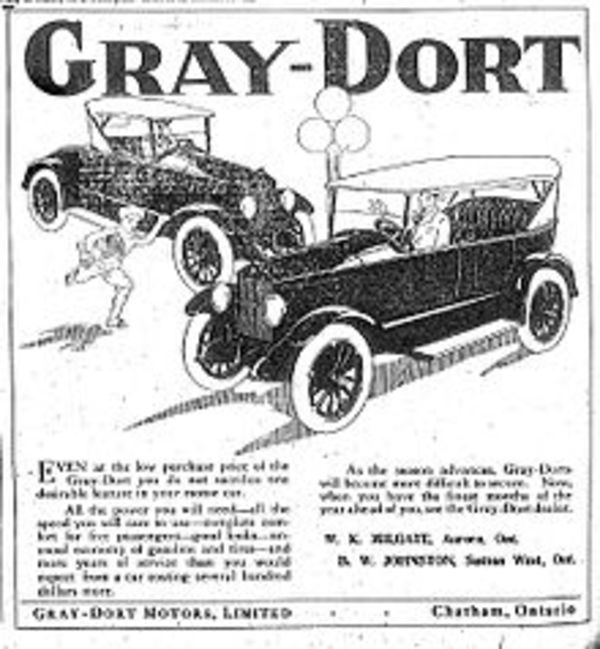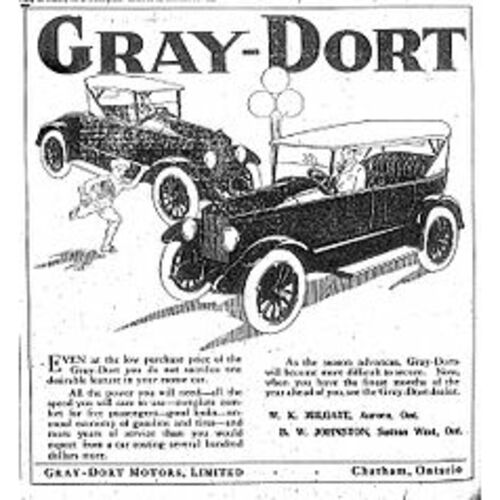
Source: Courtesy of Wikimedia Commons
GRAY, ROBERT, manufacturer; b. 3 Feb. 1862 in Chatham, Upper Canada, son of William Gray and Ellen —; m. 28 Dec. 1887 Margaret Haldane McLaren in Chatham, Ont., and they had a son and a daughter; d. there 31 March 1929.
Robert Gray was the eldest of the four children of a blacksmith who had immigrated with his wife from Roxburghshire, Scotland, in 1853. They settled in Chatham, where William Gray established a carriage-making business. In 1883 Robert and his brother, James Scott, were taken into the business, which became William Gray and Sons. The following year the 22-year-old Robert assumed control after his father slipped while disembarking from a train in Kingston and died. He rose steadily in Chatham’s business community, and became the first president of the Board of Trade. On 5 Jan. 1899 William Gray and Sons Company Limited was incorporated.
Like many carriage producers, Gray believed the advent of the automobile was the beginning of the end of carriage making, but he also saw the construction of auto bodies as an extension of the artisanal production that characterized the carriage industry. Conservatively minded, he carefully integrated auto work into his enterprise. His firm built bodies for the Still Motor Car Company of Toronto in 1899 and for the Chatham Motor Car Company from 1906. Gray’s interest in automobiles and the emerging industry would be keenly shared by his son, William Murray, who motorized a buggy in his teenage years. An owner of Detroit-made Fords, Gray Sr was an original investor in the Ford Motor Company of Canada Limited in 1904. He had offered a used Ford as partial payment, but was politely turned down by Gordon Morton McGregor, the company’s Canadian head, who needed cash more. Between 1906 and 1912 Gray would also make bodies for the Fords being assembled in Walkerville (Windsor); a strong booster of Chatham, he had tried to secure Ford work for other local companies, notably the foundry of McKeough and Trotter, and he was involved in bringing Chaplin Wheel, Dowsley Spring and Axle, and International Harvester to his native city. A shrewd businessman who would diversify his investments, in 1912 he discouraged his son from putting his savings of $6,250 into Ford stock, despite the substantial increase in value of his own shares.
Until 1916 Gray remained committed to developing his carriage business, of which automotive work was only one component. In 1907 he combined his sales force with that of the farm-equipment company of a partner in William Gray and Sons, Manson Campbell of Chatham, who had a strong distribution network in western Canada. A full merger on 24 Feb. 1911 created William Gray-Sons-Campbell Limited for the production of carriages, sleighs, fanning mills, cabinets, and auto bodies. William Gray and Sons would remain in business, but without the involvement of Robert’s accountant brother, who died in 1911. By 1912 Gray’s output had reached 15,000 wagons. When his main competitors in carriage making, Robert McLaughlin of Oshawa and James Brockett Tudhope of Orillia, expanded into making automobiles, Gray followed suit. He found an American partner to provide chassis, to beat the tariff on importing fully assembled automobiles. In October 1915 Gray and Josiah Dallas Dort, a Michigan carriage maker turned auto maker who was also president of a Canadian carriage company, created Gray-Dort Motors Limited. In the first year Gray imported fully assembled Dorts, but in 1916 he was building Gray-Dorts in Chatham. Though he ceased building carriages that year, he continued to use the Gray-Campbell network of distributors, which made his car particularly popular in Saskatchewan. Like McLaughlin, Gray was a transitional figure who had one foot planted in the old culture of carriages and personalized dealings. Known for his flexibility with customers, he once accepted a mare worth $150 as a trade-in on a Gray-Dort.
Marketed with an unassuming motto (“Own a Gray-Dort – You Will Like It”), Gray’s auto became more popular in Canada than the Dort was in the United States. It was produced in various models over the years and was admired for its power, reliability, and ease of repair. Starting with a technically advanced automobile, Gray added such features as leather upholstery, a tilting steering wheel, optional wire wheels, and even a cigar lighter. The Gray-Dort sold in the mid-price range – the 1919 touring car cost $1,275, the sedan $3,000 – and followed the McLaughlin-made Buicks and Chevrolets as Ford’s main rivals in the Canadian market. By 1921 he was making 8,000 cars annually and employing up to 825 people, and according to Bill Gray, then vice-president of Gray-Dort, 60 per cent of each car was being manufactured in Canada. The company boasted three plants in Chatham, factory branches across Canada, and some 400 dealers; 23,000 Gray-Dorts were made between 1916 and 1923. Though little is known of Gray’s day-to-day involvement, there is some evidence that the company resisted union activity and that Gray had other corporate associations. In 1920 he became a director of the Standard Bank of Canada.
In 1922 J. D. Dort decided to get out of the business. His operating costs were higher than those of his competitors in the United States, sales were low, and producers were feeling the economic downturn. His liquidation in 1924 devastated Gray’s operation. Despite the degree of Canadian manufacture, it had relied on Dort engineering and design. Like many other Canadian auto makers, Robert Gray was not the master of his own destiny. In addition, pressure from Ford and General Motors made it impossible for such small companies as Gray-Dort to continue. In 1924, with a debt of $1.2 million, it stopped making cars. By April of that year Robert Gray had left the firm, which some of its members unsuccessfully tried to keep going. Within months Bill had formed Colonial Traders Limited, to deal in automotive equipment and accessories.
Robert Gray’s interests included the Presbyterian church and the Chatham Curling Club, and the family enjoyed a summer cottage on Lake Erie at Erieau. After an illness of six months, he died in 1929 at the age of 67. Although his shares in Gray-Dort and William Gray and Sons were deemed worthless at his death, these companies had been profitable in their heyday, and he was able to leave an estate valued at almost $595,000, much of it in war loans and stock in Chrysler and GM.
The Chatham-Kent Museum in Chatham, Ont., has a Gray-Dort automobile and a strong archival collection of Gray-Dort files.
AO, F 149; RG 22-397, no.136-1929; RG 80-5-0-159, no.205469. Ont., Ministry of Consumer and Business Services, Companies and personal property security registration branch (Toronto), Dormant corporation files, TC 31828 (Gray-Dort Motors Limited). Globe, 1 April 1929. Automotive Industries (Philadelphia), 4 Sept. 1924: 464. Canada Gazette, 7 Jan. 1899: 1287; 25 Feb. 1911: 2798–99. Canadian annual rev., 1920: 64. R. A. Collins, A great way to go: the automobile in Canada (Toronto, 1969). D. F. Davis, “Dependent motorization: Canada and the automobile to the 1930s,” in The development of Canadian capitalism: essays in business history, ed. Douglas McCalla (Toronto, 1990), 191–218. Hugh Durnford and Glenn Baechler, Cars of Canada (Toronto, 1973). Industrial Canada (Toronto), 1911–24; May 1929: 150, 152. James Naylor, The new democracy: challenging the social order in industrial Ontario, 1914–25 (Toronto, 1991).
Cite This Article
Corey Larocque, “GRAY, ROBERT (1862-1929),” in Dictionary of Canadian Biography, vol. 15, University of Toronto/Université Laval, 2003–, accessed April 21, 2025, https://www.biographi.ca/en/bio/gray_robert_15E.html.
The citation above shows the format for footnotes and endnotes according to the Chicago manual of style (16th edition). Information to be used in other citation formats:
| Permalink: | https://www.biographi.ca/en/bio/gray_robert_15E.html |
| Author of Article: | Corey Larocque |
| Title of Article: | GRAY, ROBERT (1862-1929) |
| Publication Name: | Dictionary of Canadian Biography, vol. 15 |
| Publisher: | University of Toronto/Université Laval |
| Year of revision: | 2005 |
| Access Date: | April 21, 2025 |



